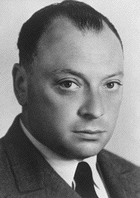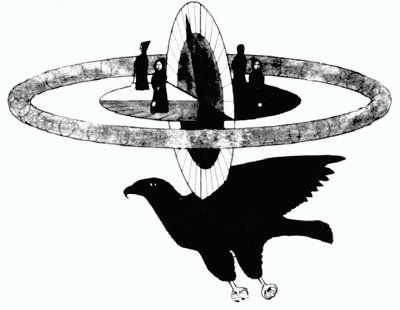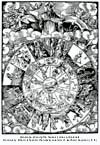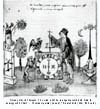Divine Contenders:
Wolfgang Pauli and the Symmetry of the World
F. David Peat
To take a one week course with David Peat
A text only version of this essay is available to download.
This essay was originally published in Psychological Perspectives: A Semi-Annual Journal of Jungian Thought, Spring-Summer 1988
Dr. F. David Peat is a theoretical physicist residing in Ottawa, Canada, whose recent book, Synchronicity: The Bridge between Matter and Mind (Bantam, 1987) generalizes Jung's views on the ultimately acausal foundation of physics and psychology. Peat is currently collaborating with David Bohm in utilizing quantum theory to update the mathematical-philosophical foundations of psychology in a series of books of which Science, Order and Creativity (Bantam, 1987) is a lucid and broadly-based introduction for the general reader. Our editor recently spent a few days with Peat and Bohm discussing their evolving world view. This essay by Peat was written in response to our editor's queries concerning what is generally known by the physicist community about the collaboration between C.G. Jung and the early quantum physicists on the foundations of analytical psychology.
A few years ago while I was researching material for a book, Synchronicity: The Bridge between Matter and Mind, I had occasion to write to a well-known physicist and student of the great Wolfgang Pauli. "Synchronicity," came his reply, "is something which physicists do not know about, nor would they wish to." His implication was clear: synchronicity smelled of pseudo science and loose thinking. Why on earth would anyone choose to get mixed up with ideas like that?
Scientists have not always exhibited such a hostile attitude toward Jung's notion of an acausal connecting principle. Jung himself, in a letter to Einstein's biographer Carl Seelig, related how he was introduced to the great physicist by one of Einstein's assistants, Ludwig Hopf. Einstein and Bleuler dined at Jung's house on a number of occasions, and the conversation turned to the physicist's early attempts at formulating the special theory of relativity. It was during these meetings that Jung first began to think about relativity of time and its psychic connections.

Carl Jung |
Synchronicity, as a firm concept, did not really occur to Jung until around 1929. It is remarkable that the development of this idea a year later coincided with the appearance of a new patient, the brilliant young physicist, Wolfgang Pauli. The relationship that grew between Jung and Pauli is remarkable and well worth the telling, for it illustrates how scientists of that period were willing to entertain Jung's ideas about synchronicity, archetypes, and the collective unconscious, and even attempt to extend them into their own fields.
That one of the creators of modern quantum theory was also deeply interested in Jung's ideas is not generally known, particularly amongst the scientific community. Indeed, I first learned of Pauli's interests while chatting with the Dutch physicist, George Uhlenbeck, shortly before a radio interview. We had been talking about Newton and his interest in alchemy as well as in the biblical books of Daniel and Revelations.
"You would be surprised," Uhlenbeck told me, "but Pauli also had unorthodox interests. In fact, he probably thought more and has written more about such things than about physics, but they have never been published." It was only later, while reading Jung's Psychology and Alchemy, that I learned that Pauli was the author of a series of the remarkable dreams analyzed in that book.

Wolfgang Pauli |
Wolfgang Pauli was born into a well-to-do Viennese family in 1900. By his late teens, he had enrolled as a student at the University of Munich under Arnold Sommerfeld. By the age of 20 he had published an account of the theory of relativity that was remarkable for the depth and maturity of its insights. He had also become the mentor of the young Werner Heisenberg. Five years later, quantum theory had been created and Pauli was now at the centre of things. Not only did he make a detailed analysis of the hydrogen atom, which convinced most physicists that the new theory had to be correct; but he was also working behind the scenes, talking with Heisenberg and Niels Bohr, and helping to develop a new philosophy for sub-atomic matter -- one which contained the radically new idea of complementarily.
Pauli was also responsible for the important exclusion principle, a profoundly new idea that was based upon notions of symmetry within the quantum domain. In fact, the principles of symmetry were to become the driving force within Pauli's intellectual life. Symmetry, for Pauli, was the archetype. It was the underlying ground out of which scientific descriptions of nature arise. Rather than seeking the ultimate level of nature in terms of elementary particles, Pauli believed that the material level is the manifestation of something deeper, a Unus Mundus that is also the domain of symmetry (Jung had adopted this Latin phrase, unus mundus or "one world," from the medieval alchemists).
When he wasn't engaged in physics, Pauli liked to frequent bars and talk long into the night. In his late twenties this hard-drinking, hard-working physicist was appointed to the Chair of Theoretical Physics at Zurich. While he continued to lecture and work with his students, however, he was also becoming increasingly irritable and in seminars, became known as Die Geissel Gottes (scourge of God) and Der fürchterlich Pauli (The Terrible Pauli). A year later, Pauli's mother had poisoned herself and he married a small-time night-club singer. The marriage broke up a few weeks later. Soon Pauli was at a crisis point; he had been thrown out of a number of bars and he now called upon Dr. Carl Jung for a consultation.
Over the next year Pauli recorded a series of his dreams which culminated in a vision of the world clock, a dream of the most subtle harmony. For Jung the diagnosis was clear: Pauli was a one-sided individual, someone whose thinking function had overwhelmed his whole being. Through a remarkable series of dreams, Pauli was able to experience what Jung believed lay close to a religious conversion. In retrospect, Jung's account of the therapeutic success of this case (in C. G. Jung: Analytical Psychology, Its Theory and Practice, 1968) may be somewhat overblown. Pauli, in fact, continued to drink to excess and could be a hard opponent at any seminar. But the physicist also had developed a deep interest in Jung's theories and, for the rest of his life, physics and psychology would play complementary roles in his thinking.
Quantum mechanics, for example, had revealed a subjective element in nature: the outcome of any quantum process depends upon the way it is perceived by the observer. In a complementary fashion, Pauli believed that this corresponded to Jung's discovery of an objective layer to mind -- the collective unconscious. Matter and mind were both recognized as having objective and subjective layers. They are complementary in their structure and, at the psychoid level, each reflects the other.
Pauli's world clock had revolved upon an axis which was both part of the movement and yet stationary. This axis was a speculum, a mirror that stood between two worlds reflecting one into the other. This speculum also entered into the essence of Pauli's approach to physics. For the speculum can also be taken as the mathematical mirror which generates symmetry, whereby its abstract operations reflect quantum states or elementary particles, one into the other.
Over the years that followed, Pauli continued to work as a theoretical physicist, attempting to bring order into the increasingly complex world of the elementary particles. He also began to attend meetings of Jung's analytical psychology group in Zurich. At first, he did not appear to have made much impact, but as time went on and his reputation rose -- culminating in a Nobel Prize in 1945 -- Pauli's ideas gained in prominence. In particular, he appears to have had a number of discussions with Jung on the subject of the nature of synchronicity and to have suggested a duality between synchronicity and causality and between energy and the space-time continuum.
During these years Pauli also introduced Jung's ideas to a number of important physicists, most notably Heisenberg, but also Pascual Jordan and Markus Fierz, who appear to have taken Jung's ideas seriously and to have corresponded with him.
Pauli became interested in how new scientific ideas and theories are generated. Ernst Mach and the logical positivists had suggested that scientific theories are essentially suggested by empirical facts and that extraneous metaphysical notions should be rigorously excluded. Pauli realized, however, that theories cannot be deduced from facts alone; science is a creative, artistic pursuit in which theories emerge from a deeper ground. But how?
Just as matter has its subjective side, as shown through the quantum measurement process, so, too, mind has an objective side. The human mind possesses an aspect that goes beyond the purely personal and is not connected entirely to individual experience. This objective or collective side appears to lie within the same ground as that of matter itself. Mind and matter, emerging out of the Unus Mundus, contain the imprint of their origin, the internal structures and relationships that could be called variously the archetypes or abstract symmetries.
(More recently, physicist David Bohm has called attention to what he terms the "implicate order" and the "generative order." These seem to give a better account, from a quantum theoretical point of view, of how the various structures of nature emerge out of an underlying ground. These ideas are presented in detail in David Bohm and David Peat's book, Science, Order and Creativity.)
By drawing upon such archetypes, a truly creative physicist is able to formulate new theories. Theories of nature are not produced in an arbitrary fashion or simply as a way of relating facts together. They are true creations of the human mind, the origins of which lie deep within the objective unconscious, at the speculum that reflects matter and mind. Scientific theories in this way reflect nature back onto itself.
It was through his study of Kepler and the evolution of the laws of planetary motion that Pauli finally formulated these ideas. Nature, according to Kepler, was not simply mathematical and rational but also had a magical-symbolic aspect. It was as if sun and planets were an integrated, living whole. Since Kepler believed in the famous dictum, "as above so below," it was natural to assume that the solar system reflected an image of the Trinity and the human mind itself.
Such ideas are certainly not far-fetched. David Bohm has told me how, while working on his theory of the plasma state, he felt that the whole plasma was a living thing, a society of electrons, as it were. [See our interview with David Bohm in this issue.] Over the past decade, Bohm has been lecturing and thinking not only about physics but also about society, religion, and human consciousness. He explores these integrations on many levels without any sense of inner division.
This approach would be familiar to Pauli, who pointed out how science and religion have a common origin which, alas, has been forgotten today. Throughout the rest of his life, Pauli continually stressed the need for unification, for a bridging between our scientific knowledge of the world of external objects and our psychological knowledge of inner reality. It is clear that Pauli felt that Jungian psychology could play a role in this transformation and that a unity could be forged between physics and psychology. From what he said to colleagues in later years, Pauli appears to have felt that physics was (and in my opinion, still is) in a transitory stage preceding much deeper insight. Quantum theory was only the first step; something truly revolutionary is to follow, which will move us far beyond the conventional boundaries of physics.
But even the physics of his time was not in harmony with itself and, during the final years of his life, Pauli struggled to create a unified theory of the elementary particles. In this task his old friend Werner Heisenberg became his companion and, as always, symmetry was the guiding principle. In December 1957 he wrote to Heisenberg:
Division and reduction of symmetry, this then is the kernel of the brute! The former is the ancient attribute of the devil. If only the two divine contenders -- Christ and the devil -- could notice that they have grown so much more symmetrical.
In great excitement Pauli rushed off to the United States to lecture on this work. Heisenberg had never found him so excited. But, in the end, their theory would not work. Pauli appears to have encountered serious criticism. He returned to Zurich a changed man, almost a total reversion to his former, critical, hostile state. He refused to reply to Heisenberg's letters and gave up all research. By the end of 1958, he was dead.
Pauli's death was a loss not only to the field of physics but also to Carl Jung, who had looked upon him as the only physicist with sufficient stature and insight to bring about this unification between quantum physics and the psychology of the unconscious.
Now both men are dead. Physics has undergone great advances with its grand unified theories and its current development of superstring theory. Yet the central question remains: What is the nature of Pauli's great dream? What is that speculum that lies between the worlds of mind and matter? Will it be possible to develop a new physics and a new psychology which are complementary to each other?
This is not simply some intellectual problem or an idle inquiry; rather, it is vital to our very human survival. Science and technology have reached such levels of sophistication that they are changing the planet, society, and the nature of life itself. We can no longer afford for this to continue uncontrolled. We can no longer survive with such a fragmented view of nature. Jung and Pauli's call for a unified approach is even more significant today than it was thirty years ago.
The Vision of the World Clock
The vision of the world clock described in Peat's article was originally published by C. G. Jung as follows (Psychology and Alchemy):
There is a vertical and a horizontal circle, having a common centre. This is the world clock. It is supported by the black bird.
The vertical circle is a blue disc with a white border divided into 4 X 8 -- 32 partitions. A pointer rotates upon it.
The horizontal circle consists of four colours. On it stand four little men with pendulums, and round it is laid the ring that was once dark and is now golden (formerly carried by four children). The world clock has three rhythms or pulses:
1) The small pulse: the pointer on the blue vertical disc advances by 1/32.
2) The middle pulse: one complete rotation of the pointer. At the same time the horizontal circle advances by 1/32.
3) The great pulse: 32 middle pulses are equal to one complete rotation of the golden ring. (p. 194)

The World Clock. An impression generated by artist W. Beyers-Brown based on accounts of Pauli's dream. |
Jung discusses this vision of the world clock in two books: Psychology and Religion (Vol. XI of Jung's Collected Works) and Psychology and Alchemy (Vol. XII). The following quotations are from the former:
The vision sums up all the allusions in the previous dreams. It seems to be an attempt to make a meaningful whole of the formerly fragmentary symbols, then characterized as circle, globe, square, rotation, clock, star, cross, quaternity, time, and so on.
It is of course difficult to understand why a feeling of "most sublime harmony" should be produced by this abstract structure. But if we think of the two circles in Plato's Timaeus, and of the harmonious all-roundness of his anima mundi, we might find an avenue to understanding. Again, the term "world clock" suggests the antique conception of the musical harmony of the spheres. It would thus be a sort of cosmological system. If it were a vision of the firmament and its silent rotation, or of the steady movement of the solar system, we could readily understand and appreciate the perfect harmony of the picture. We might also assume that the platonic vision of the cosmos was faintly glimmering through the mist of a dreamlike consciousness. But there is something in the vision that does not quite accord with the harmonious perfection of the platonic picture. The two circles are each of a different nature. Not only is their movement different, but their colour too.
The vertical circle is blue and the horizontal one containing four colours is golden. The blue circle might easily symbolize the blue hemisphere of the sky, while the horizontal circle would represent the horizon with its four cardinal points, personified by the four little men and characterized by the four colours. (In a former dream, the four points were represented once by four children and another time by the four seasons.) This picture immediately calls to mind the medieval representations of the world in the form of a circle or in a shape of the rex gloriae with the four evangelists, or the melothesia, where the horizon is formed by the zodiac. The representation of the triumphant Christ seems to be derived from similar pictures of Horus and his four sons. There are also Eastern analogies: the Buddhist mandalas or circles, usually of Tibetan origin. These consist as a rule of a circular padma or lotus which contains a square sacred building with four gates, indicating the four cardinal points and the seasons. The centre contains a Buddha, or more often the conjunction of Shiva and his Shakti, or an equivalent dorje (thunderbolt) symbol. They are yantras or ritualistic instruments for the purpose of contemplation, concentration, and the final transformation of the yogi's consciousness into the divine all-consciousness.
However striking these analogies may be, they are not entirely satisfactory, because they all emphasize the centre to such an extent that they seem to have been made in order to express the importance of the central figure. In our case, however, the centre is empty. It consists only of a mathematical point. The parallels I have mentioned depict the world-creating or world-ruling deity, or else man in his dependence upon the celestial constellations. (pp. 66-67)
If we allow ourselves to draw conclusions from modern mandalas we should ask people, first, whether they worship stars, suns, flowers, and snakes. They will deny this, and at the same time they will assert that the globes, stars, crosses, and the like are symbols for a centre in themselves. And if asked what they mean by this centre, they will begin to stammer and to refer to this or that experience which may turn out to be something very similar to the confession of my patient, who found that the vision of his world clock had left him with a wonderful feeling of perfect harmony. Others will confess that a similar vision came to them in a moment of extreme pain or profound despair. To others again it is the memory of a sublime dream or of a moment when long and fruitless struggles came to an end and a reign of peace began. If you sum up what people tell you about their experiences, you can formulate it this way: They came to themselves, they could accept themselves, they were able to become reconciled to themselves, and thus were reconciled to adverse circumstances and events. This is almost like what used to be expressed by saying: He has made his peace with God, he has sacrificed his own will, he has submitted himself to the will of God.
A modern mandala is an involuntary confession of a peculiar mental condition. There is no deity in the mandala, nor is there any submission or reconciliation to a deity. The place of the deity seems to be taken by the wholeness of man. (pp. 81-82).
From Dreams, C.G.Jung, pp.280-1

The Horoscope.
Click to enlarge. |

Time.
Click to enlarge. |
As to the interpretation based on comparative historical material, we are in a more favourable position, at least as regards the general aspects of the figure. We have at our disposal, firstly, the whole mandala symbolism of three continents, and secondly, the specific time symbolism of the mandala as this developed under the influence of astrology, particularly in the West. The horoscope is itself a mandala (a clock) with a dark centre, and a leftward circumambulatio with "houses" and planetary phases. The mandalas of ecclesiastical art, particularly those on the floor before the high altar or beneath the transept, make frequent use of the zodiacal beasts or the yearly seasons. A related idea is the identity of Christ with the Church calendar, of which he is the fixed pole and the life. The Son of Man is an anticipation of the idea of the self: hence the Gnostic adulteration of Christ with the other synonyms for the self among the Nassenes, recorded by Hippolytus.
Related Pages:
Carl Jung | Archetypes | Synchronicity
Contact F. David Peat
|





